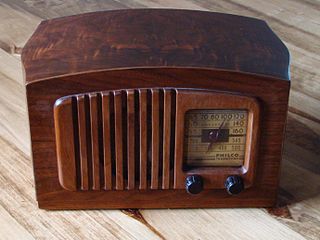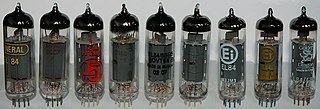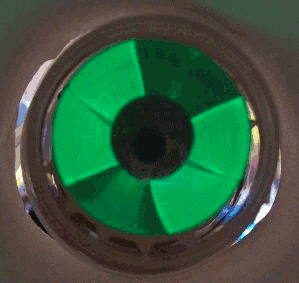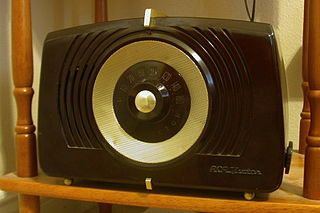
A triode is an electronic amplifying vacuum tube consisting of three electrodes inside an evacuated glass envelope: a heated filament or cathode, a grid, and a plate (anode). Developed from Lee De Forest's 1906 Audion, a partial vacuum tube that added a grid electrode to the thermionic diode, the triode was the first practical electronic amplifier and the ancestor of other types of vacuum tubes such as the tetrode and pentode. Its invention helped make amplified radio technology and long-distance telephony possible. Triodes were widely used in consumer electronics devices such as radios and televisions until the 1970s, when transistors replaced them. Today, their main remaining use is in high-power RF amplifiers in radio transmitters and industrial RF heating devices. In recent years there has been a resurgence in demand for low power triodes due to renewed interest in tube-type audio systems by audiophiles who prefer the sound of tube-based electronics.

A vacuum tube, electron tube, valve, or tube is a device that controls electric current flow in a high vacuum between electrodes to which an electric potential difference has been applied.

A rectifier is an electrical device that converts alternating current (AC), which periodically reverses direction, to direct current (DC), which flows in only one direction.

A DC connector is an electrical connector that supplies direct current (DC) power.

12AX7 is a miniature dual-triode vacuum tube with high voltage gain. Developed around 1946 by RCA engineers in Camden, New Jersey, under developmental number A-4522, it was released for public sale under the 12AX7 identifier on September 15, 1947.

6SN7 is a dual triode vacuum tube with an eight-pin octal base. It provides a medium gain. The 6SN7 is basically two 6J5 triodes in one envelope.

Tube sockets are electrical sockets into which vacuum tubes can be plugged, holding them in place and providing terminals, which can be soldered into the circuit, for each of the pins. Sockets are designed to allow tubes to be inserted in only one orientation. They were used in most tube electronic equipment to allow easy removal and replacement. When tube equipment was common, retailers such as drug stores had vacuum tube testers, and sold replacement tubes. Some Nixie tubes were also designed to use sockets.

The term All American Five is a colloquial name for mass-produced, superheterodyne radio receivers that used five vacuum tubes in their design. These radio sets were designed to receive amplitude modulation (AM) broadcasts in the medium wave band, and were manufactured in the United States from the mid-1930s until the early 1960s. By eliminating a power transformer, cost of the units was kept low; the same principle was later applied to television receivers. Variations in the design for lower cost, shortwave bands, better performance or special power supplies existed, although many sets used an identical set of vacuum tubes.

A voltage-regulator tube is an electronic component used as a shunt regulator to hold a voltage constant at a predetermined level.

The 6V6 is a beam-power tetrode vacuum tube. The first of this family of tubes to be introduced was the 6V6G by Ken-Rad Tube & Lamp Corporation in late 1936, with the availability by December of both Ken-Rad and Raytheon 6V6G tubes announced. It is still in use in audio applications, especially electric guitar amplifiers.

The EL34 is a thermionic vacuum tube of the power pentode type. The EL34 was introduced in 1955 by Mullard, who were owned by Philips. The EL34 has an octal base and is found mainly in the final output stages of audio amplification circuits; it was also designed to be suitable as a series regulator by virtue of its high permissible voltage between heater and cathode and other parameters. The American RETMA tube designation number for this tube is 6CA7. The USSR analog was 6P27S.

The EL84 is a vacuum tube of the power pentode type. It is used in the power-output stages of audio amplifiers, most commonly now in guitar amplifiers, but originally in radios. The EL84 is smaller and more sensitive than the octal 6V6 that was widely used around the world until the 1960s. An interchangeable North American type is the 6BQ5.
In Europe, the principal method of numbering vacuum tubes was the nomenclature used by the Philips company and its subsidiaries Mullard in the UK, Valvo(de, it) in Germany, Radiotechnique (Miniwatt-Dario brand) in France, and Amperex in the United States, from 1934 on. Adhering manufacturers include AEG (de), CdL (1921, French Mazda brand), CIFTE (fr, Mazda-Belvu brand), EdiSwan (British Mazda brand), Lorenz (de), MBLE(fr, nl), RCA (us), RFT(de, sv) (de), Siemens (de), Telefunken (de), Tesla (cz), Toshiba (ja), Tungsram (hu), and Unitra. This system allocated meaningful codes to tubes based on their function and became the starting point for the Pro Electron naming scheme for active devices.
A valve audio amplifier (UK) or vacuum tube audio amplifier (US) is a valve amplifier used for sound reinforcement, sound recording and reproduction.
A double diode triode is a type of electronic vacuum tube once widely used in radio receivers. The tube has a triode for amplification, along with two diodes, one typically for use as a detector and the other as a rectifier for automatic gain control, in one envelope. In practice the two diodes usually share a common cathode. Multiple tube sections in one envelope minimized the number of tubes required in a radio or other apparatus.

A magic eye tube or tuning indicator, in technical literature called an electron-ray indicator tube, is a vacuum tube which gives a visual indication of the amplitude of an electronic signal, such as an audio output, radio-frequency signal strength, or other functions. The magic eye is a specific type of such a tube with a circular display similar to the EM34 illustrated. Its first broad application was as a tuning indicator in radio receivers, to give an indication of the relative strength of the received radio signal, to show when a radio station was properly tuned in.

An AC/DC receiver design is a style of power supply of vacuum tube radio or television receivers that eliminated the bulky and expensive mains transformer. A side-effect of the design was that the receiver could in principle operate from a DC supply as well as an AC supply. Consequently, they were known as "AC/DC receivers".

The 807 is a beam tetrode vacuum tube, widely used in audio- and radio-frequency power amplifier applications.

















